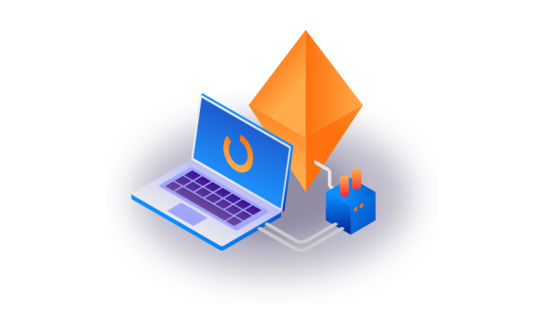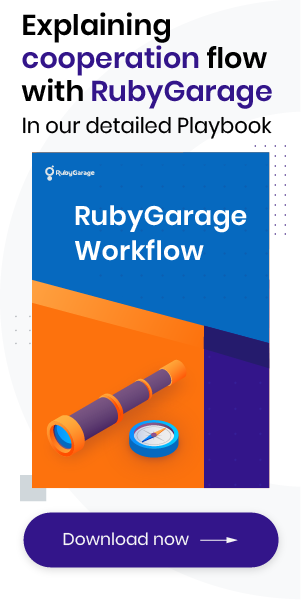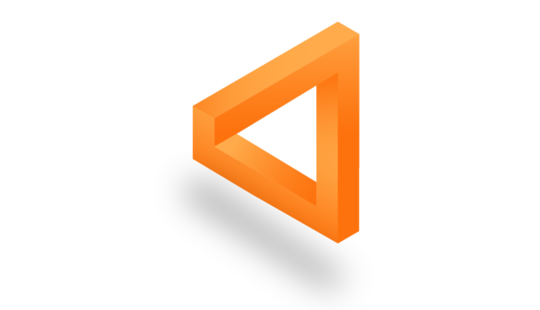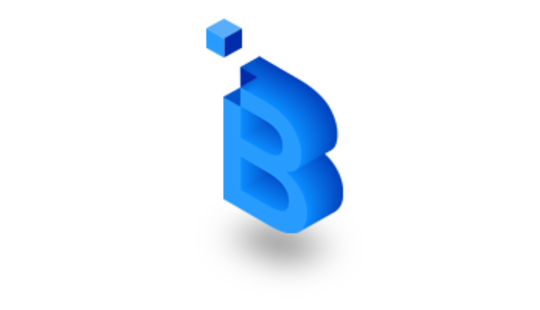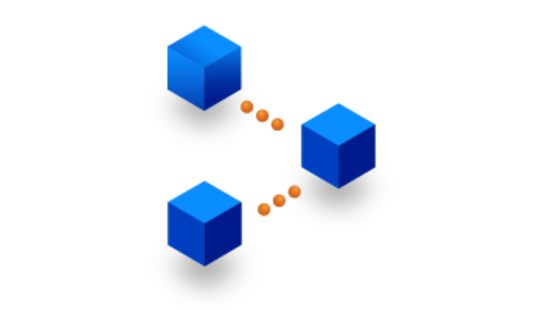-
Product Management
Software Testing
Technology Consulting
-
Multi-Vendor Marketplace
Online StoreCreate an online store with unique design and features at minimal cost using our MarketAge solutionCustom MarketplaceGet a unique, scalable, and cost-effective online marketplace with minimum time to marketTelemedicine SoftwareGet a cost-efficient, HIPAA-compliant telemedicine solution tailored to your facility's requirementsChat AppGet a customizable chat solution to connect users across multiple apps and platformsCustom Booking SystemImprove your business operations and expand to new markets with our appointment booking solutionVideo ConferencingAdjust our video conferencing solution for your business needsFor EnterpriseScale, automate, and improve business processes in your enterprise with our custom software solutionsFor StartupsTurn your startup ideas into viable, value-driven, and commercially successful software solutions -
-
- Case Studies
- Blog
Top 6 Blockchain Frameworks to Build Your App
The blockchain is a proven technology that can be used anywhere. Interest in blockchain-based apps is increasing in all spheres. No matter the sphere you’re building software for — finance, commerce, healthcare, government, agriculture — you need to learn how to work with blockchains quickly and easily. For that, you have to choose a blockchain framework that meets your needs and fits your projects.
Below, you can find an examination of the six most useful blockchain frameworks and a comparison of their characteristics.
Exonum
Exonum is a blockchain framework developed for enterprise projects and launched in 2017 by the Bitfury Group. The Exonum source code is absolutely open, as are all application programming interfaces (APIs). Exonum provides access not only to the whole codebase but to client software for blockchain management. It was built with the help of Rust, one of the safest and fastest programming languages. Rust is currently faster than Java, C, C++, and even Go.
As a developer, you can use Exonum to build solutions for FinTech, GovTech, LegalTech, and many other fields. The main characteristics of this framework are the following:
- Exonum is an independent system, as it doesn’t require mining and doesn’t depend on any cryptocurrency.
- Exonum blockchains work very fast, processing about 5,000 transactions a second.
- Exonum has a Light Client that can check the availability and correctness of user data as well as the anchorage status of that data.
- Exonum relies on services that work similarly to smart contracts but are more flexible and adaptable.
Companies that use Exonum-based apps for their financial systems also get another benefit: Exonum avoids the possibility of double-entry bookkeeping and all sorts of document forgery.
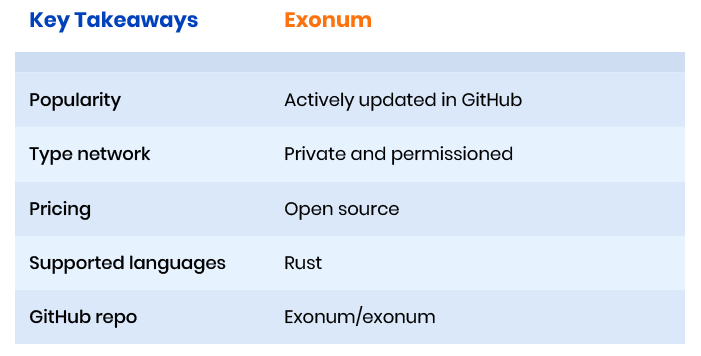
Case studies
Exonum was used as a core technology to build blockchain-based government land registry and cadastre systems for Ukraine and Georgia. These systems have been successfully used since 2015 and 2016 respectively.
Exonum was also used in a set of pilot projects that advanced all DevOps processes at engineering research company Aricent. The company’s executives reported a product development cycle acceleration by 34% after the launch of their blockchain solution.
The Exonum framework is popular, has a strong community, and is often updated. You can get the source code on the official website or on GitHub.
Hyperledger
In 2016, the Linux Foundation started the Hyperledger project. Similar to Exonum, Hyperledger is open-source and doesn’t support any cryptocurrency.
Hyperledger was designed as an environment where different communities and individual developers can meet and work together on blockchain technologies. The result of this cooperation is a set of blockchain tools for building financial, healthcare, banking, IoT, supply chain, and other projects.
The Hyperledger project is funded by its members.
The framework is based on the “umbrella strategy.” This means the project is not one tool but a set of libraries, instruments, frameworks, and interfaces. The most well-known and commonly used Hyperledger frameworks are:
- Hyperledger Sawtooth. Intel has created a blockchain suite with a modular architecture based on the PoET consensus algorithm.
- Hyperledger Iroha. Several Japanese companies cooperated to create this project. The result is a mobile-oriented blockchain framework that’s easy to implement into an existing solution.
- Hyperledger Fabric. Created by IBM, this is the most famous instrument among all Hyperledger frameworks. Fabric is a great solution for creating highly scalable apps.
- Hyperledger Burrow. This tool was designed by Monax in cooperation with Intel. It operates as a permissioned Ethereum smart contract blockchain node.
In addition, Hyperledger provides developers with tools to help them create, manage, and terminate Hyperledger frameworks.
As we’ve mentioned, Fabric is used more often than any other Hyperledger framework. Its popularity can be explained by its many advantages, including:
- Modular structure. The framework is very flexible, and you can easily modify it according to your needs. At the same time, the modular structure makes your system scalable and maintainable.
- Private channels. If you need to send data to a particular participant, the private channel feature allows you to do it without displaying data to other participants.
- Strong community. Fabric gets strong support from such giants as Intel and IBM, which contributes to the framework’s fast development and improvement.
- Fast development. An abundance of ready-made solutions and tools help developers create apps with clean code and a well-considered architecture.
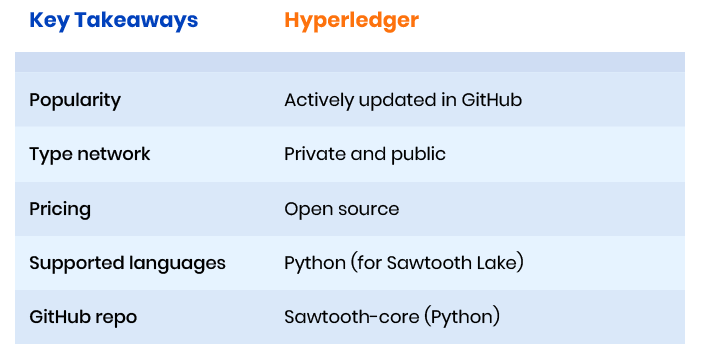
Case studies
Participants in the Hyperledger project use Hyperledger solutions for their internal systems. Additionally, a lot of other entities have created apps based on Hyperledger frameworks.
For instance, the Postal Savings Bank of China uses an app created by IBM and based on Hyperledger Fabric.
MpnetaGo used Hyperledger Fabric for India’s first enterprise blockchain network for multiple financial services organizations.
Hyperledger gets huge support from its contributors and is actively updated on GitHub.
Openchain
This framework was launched by Coinprism. It’s designed for issuing and managing digital assets. The Openchain distributed ledger aims to meet the needs of banking establishments and financial institutions. Openchain solutions allow financial establishments to effectively manage all financial processes and enhance anti-fraud and anti-money laundering systems. It’s a great option if you need to optimize your organization’s infrastructure and adapt it to different needs.
Openchain relies on a partitioned consensus algorithm where every instance has only one authority with the right to validate transactions. This creates a client-server architecture which, as the framework developers claim, is more reliable than the usual peer-to-peer architecture. The developers also promise full control over the infrastructure with the required level of transparency.
The Openchain framework has a number of peculiarities you need to know about:
- Tokens can be linked with Bitcoin by means of sidechains.
- Openchain relies on smart contract modules.
- The framework has a unified API, allowing you to interact with different Openchain instances.
- Openchain allows you to create several blockchains that copy each other.
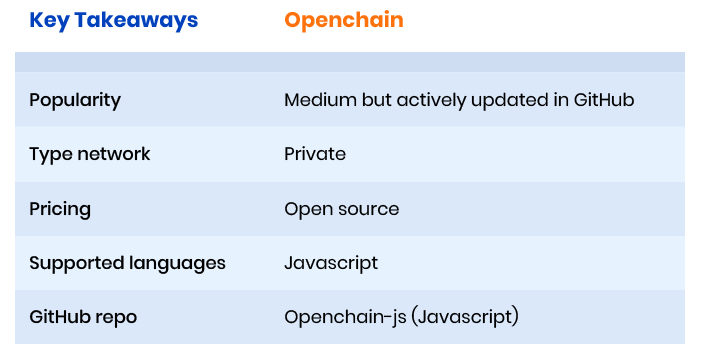
Case studies
Openchain has been applied in a number of different projects by its 14 Platinum members. Among the most well-known are GitHub, Adobe, Hitachi, Toyota, Sony, and Qualcomm.
However, despite all its benefits and well-known contributors, the community around Openchain isn’t very active compared to the communities around previous frameworks. The last code commit to the project on GitHub was about two years ago.
Graphene
Cryptonomex launched the Graphene platform for deploying blockchains. This framework is mostly written in C++ and has a modular structure which makes it very adaptable. Initially, Graphene was created as the foundation of Bitshares, a cryptocurrency exchange. Yet the platform became so popular that it has found many applications in different areas.
Today, Graphene offers a long list of financial services. And a lot of financial establishments choose Graphene because of its transparency and reliability. Graphene brings the following advantages over its competitors:
- Can process up to 3,000 transactions per second. Moreover, Graphene developers claim the system is capable of processing even 100,000 transactions per second. This speed is enough to provide large economic and financial companies with continuous operations.
- A new block is formed within three seconds, compared to 10 minutes for other blockchain.
- Supports payments with zero commission.
- Permits simultaneous work with several tokens in a single system.
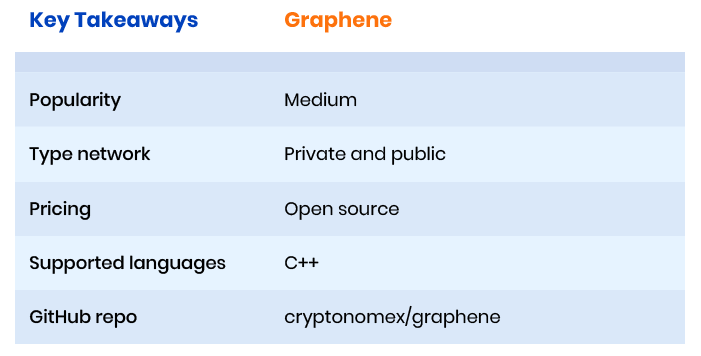
Case studies
The first Graphene implementations were in the BitShares cryptocurrency, the revolutionary P2P betting platform PeerPlays, and the Steemit social media platform, where users are paid for unique content or for monitoring this content.
Despite such popularity, nowadays Graphene isn’t updated very often on GitHub.
Still believe that smart contract is just a futuristic concept? Read our article and learn how smart contracts can help your business.Corda
Corda is a product of R3. The company wanted to design a framework specifically for the financial sphere and wanted Corda to work as a mediator and remove expensive business transactions. The framework allows businesses to reduce transaction and record-keeping costs and streamline business operations.
Corda is an open-source technology that can be used to store, manage, control, and synchronize financial obligations between different organizations. It helps organizations build an open network to transfer value directly with trust. And you can get it all with complete privacy.
Corda is written in Kotlin and Java and runs on the Java Virtual Machine (JVM). This means you can use the wide range of libraries and third-party code that exists for the Java platform.
Characteristics of the Corda platform:
- It’s not necessary to make information available for all participants in the system.
- Transactions can be confirmed only by participants who have access to the system.
- There’s no central controller to manage the flow of information in the systems built on Corda.
- You can use various consensus algorithms.
- Corda does not have an internal currency.
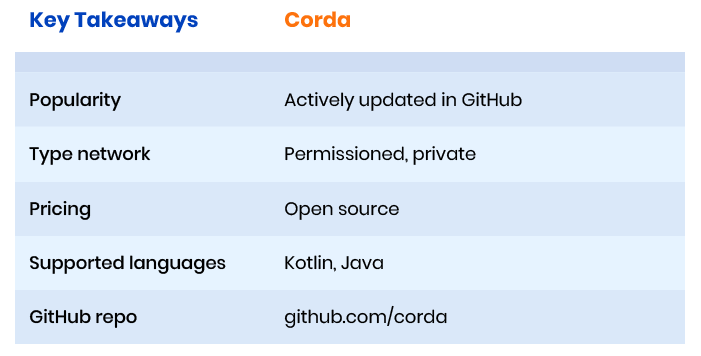
Case studies
More than 10 banks worldwide have chosen Corda to develop their financial trading projects. The most famous of these banks are HSBC, SEB, Bangkok Bank, the Royal Bank of Scotland, and BBVA.
This cooperation has given R3 the knowledge and experience to create a financial trading application on Corda that incorporates shippers and carriers.
The Corda project is popular and has a large community, which is why it’s updated regularly on GitHub.
MultiChain
The MultiChain framework belongs to the Coin Science company. This is an out-of-the-box solution you can apply to build and deploy a private blockchain for your company or for use by several companies. MultiChain was created to overcome major obstacles to deploying blockchains in the financial sector. The framework offers a turnkey package with the necessary privacy and access levels. For ease of use, MultiChain has a simple API, a command-line interface, and supports almost all server operating systems.
MultiChain is based on the mining principle and offers privacy and openness with a feature for managing user permissions. Participants can manage the size of blocks, so there are no problems with scaling.
MultiChain has the following characteristics:
- All participants have their own private key, which helps them get full control over their assets.
- MultiChain blockchains are decentralized.
- MultiChain solutions are reliable. The system doesn’t depend on a particular server and, in case the server fails, it won’t affect the continued processing of transactions.
- MultiChain is highly configurable and customizable; it can work with several blockchains simultaneously. MultiChain developers claim the system is so easy to work with that it can be easily deployed and configured by a non-developer.
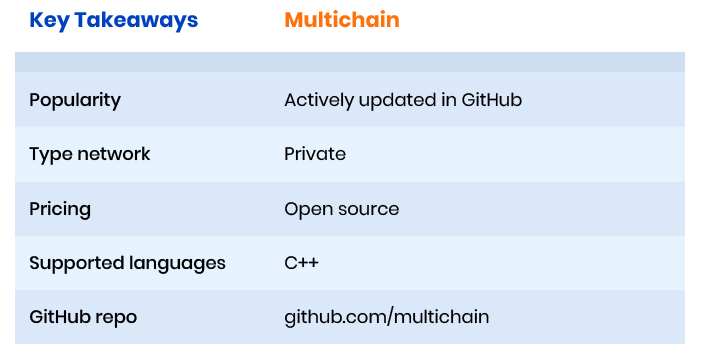
Case studies
Wolfram Research, a private company that creates computational technologies, has integrated the MultiChain platform into their software system. MultiChain works as a multipurpose database for this project.
The MultiChain project is actively updated on GitHub and has a large community.
Comparison
To help you choose the most suitable blockchain framework for your project, we’ve compared the characteristics of these six frameworks in a table.
| Exonum | Hyperledger | Openchain | Graphene | Corda | MultiChain | |
|---|---|---|---|---|---|---|
| Code type | Open-source | Open-source | Open-source | Open-source | Open-source | Open-source |
| Community | Regular updates | Regular updates | Not very active | Not very active | Regular updates | Regular updates |
| Industry focus | FinTech, GovTech LegalTech | Cross-industry | Cross-industry | Cross-industry | Financial services | Financial services |
| Governance | The Bitfury Group | The Linux Foundation | Coinprism | Cryptonomex | R3 consortium | Coin Science |
| Ledger type | Private and permissioned | Private and public | Private | Private and public | Permissioned | Private |
| Cryptocurrency | None | None | Aircoin | Bitshares | None | None |
| Language | Rust | Python | JavaScript | C++ | Kotlin, Java | C++ |
| Smart contract functionality | Yes | Yes | Yes | Yes | Yes | Yes |
| Best projects | Land registry and land cadastre systems for Georgia and Ukraine | Banking app for Postal Savings Bank of China, DLT.sg Singapore blockchain apps | Used in projects for Adobe, Arm, Cisco, Comcast, GitHub, Harman, Hitachi, HPE, Qualcomm, Siemens, Sony, Toyota, Western Digital, and Wind River | Steemit, BitShares, Peerplay | Banking systems for Bangkok Bank, BBVA, BNP Paribas, HSBC, ING | Wolfram Research |
As you can see, all these frameworks are open-source and mostly target the financial sector. They all have smart contract functionality or its analogue. Other features vary.
Wrapping up
Blockchain frameworks help developers work faster and more efficiently. Moreover, the variety of these frameworks is so large that every developer can choose one no matter how sophisticated and complex the project.
If this is the first time you’re choosing a blockchain framework for your project, we recommend starting with a framework that has a strong community and developer support. That way if an issue occurs, you can always contact more experienced developers and get help.
FAQ
-
- Exonum
- Hyperledger
- Openchain
- Graphene
- Corda
- MultiChain
-
- Hyperledger Sawtooth;
- Hyperledger Iroha;
- Hyperledger Fabric;
- Hyperledger Burrow.
-
More than 10 banks worldwide have chosen Corda framework to develop their financial trading projects. The most famous of these banks are:
- HSBC,
- SEB,
- Bangkok Bank,
- the Royal Bank of Scotland,
- BBVA.



